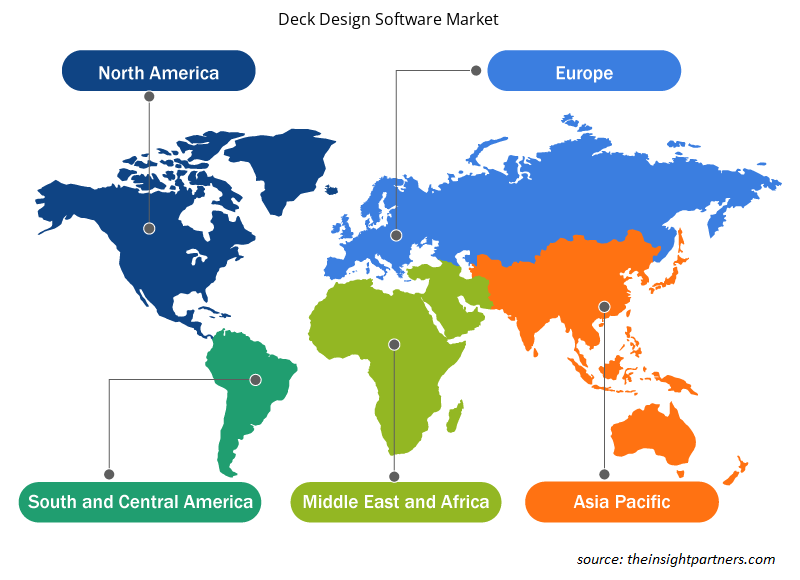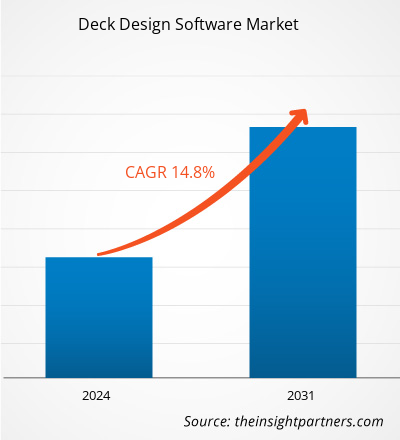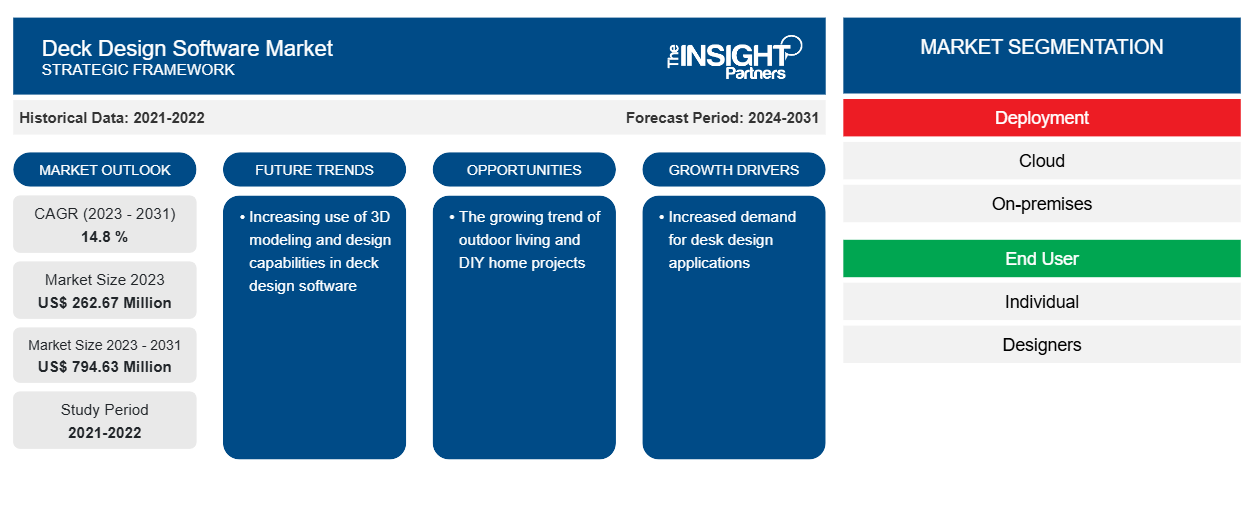Der Markt für Deckdesign-Software wird voraussichtlich von 262,67 Millionen US-Dollar im Jahr 2023 auf 794,63 Millionen US-Dollar im Jahr 2031 anwachsen. Der Markt wird voraussichtlich zwischen 2023 und 2031 eine durchschnittliche jährliche Wachstumsrate (CAGR) von 14,8 % verzeichnen. Die zunehmende Nutzung von 3D-Modellierungs- und Designfunktionen in Deckdesign-Software wird wahrscheinlich ein wichtiger Trend auf dem Markt für Deckdesign-Software bleiben.
Marktanalyse für Deckdesign-Software
Die zunehmende Verwendung dieser Tools in den Bereichen Bau und Hausrenovierung wird voraussichtlich zu einem deutlichen Wachstum des globalen Marktes für Terrassendesign-Software führen. Immer mehr Menschen versuchen, ihre Außenbereiche zu modernisieren. Es wird erwartet, dass der Markt aufgrund der steigenden Beliebtheit von Terrassenbelägen und der Verfügbarkeit von Hightech-Terrassentools wachsen wird. Darüber hinaus wird erwartet, dass wachsende Sicherheitsbedenken infolge von Naturkatastrophen die Nachfrage nach Terrassendesign-Software erhöhen werden. Terrassendesign-Software erfreut sich wachsender Beliebtheit, da die Branche auf eine stärker mechanisierte und digitalisierte Zukunft zusteuert. Profis verwenden sie häufig wegen ihrer zahlreichen Funktionen, zu denen 3D- Visualisierung , automatisches Zeichnen und effektives Projektmanagement gehören .
Marktübersicht für Deckdesign-Software
Ein elektronisches Werkzeug zum Planen, Entwerfen und Visualisieren von Außenterrassen ist eine Terrassendesign-Software. Mithilfe dieser Art von Software können Sie Terrassen in verschiedenen Größen und Formen erstellen, ändern und entwerfen. Sie können auch Bilder des 3D-Designs machen und diese an Kunden oder Mitarbeiter senden. Um sicherzustellen, dass Terrassenstrukturen Industriestandards und Sicherheitsvorschriften erfüllen, wird im Konstruktionsprozess auch Terrassendesign-Software eingesetzt.
Passen Sie diesen Bericht Ihren Anforderungen an
Sie erhalten kostenlose Anpassungen an jedem Bericht, einschließlich Teilen dieses Berichts oder einer Analyse auf Länderebene, eines Excel-Datenpakets sowie tolle Angebote und Rabatte für Start-ups und Universitäten.
-
Holen Sie sich die wichtigsten Markttrends aus diesem Bericht.Dieses KOSTENLOSE Beispiel umfasst eine Datenanalyse von Markttrends bis hin zu Schätzungen und Prognosen.
Treiber und Chancen auf dem Markt für Deckdesign-Software
Erhöhte Nachfrage nach Schreibtisch-Design-Anwendungen
Der Bedarf an Terrassendesign-Anwendungen wächst, da immer mehr Hausbesitzer und Bauunternehmer ihre Terrassen planen und visualisieren möchten, bevor sie mit dem Bau beginnen. Mit einer Terrassendesign-Software können Benutzer die Größe oder Form der Terrasse schnell und einfach ändern, mit zahlreichen Designmöglichkeiten experimentieren und das fertige Produkt in drei Dimensionen betrachten. Dies erleichtert den Prozess der Planung und des Baus von Terrassen und verringert die Notwendigkeit kostspieliger persönlicher Gespräche mit Bauunternehmern.
Der wachsende Trend zum Leben im Freien und zu Heimwerkerprojekten
Terrassendesign-Software erfreut sich aufgrund der wachsenden Trends zum Leben im Freien und Heimwerker-Verbesserungen immer größerer Beliebtheit. Immer mehr Hausbesitzer führen Heimwerkerprojekte durch, wie den Bau von Terrassen und Außenküchen , um ihre Außenwohnbereiche zu verschönern. Mithilfe von Terrassendesign-Software können Hausbesitzer ihre Terrasse einfacher und präziser planen und visualisieren, bevor sie mit dem Bau beginnen, und so möglicherweise Geld und Zeit sparen. Daher wird erwartet, dass die zunehmende Verbreitung des IoT den Akteuren auf dem Markt für Terrassendesign-Software im Prognosezeitraum neue Möglichkeiten bietet.
Marktbericht zur Deckdesign-Software – Segmentierungsanalyse
Wichtige Segmente, die zur Ableitung der Marktanalyse für Deckdesign-Software beigetragen haben, sind Bereitstellung, Endbenutzer und Anwendung.
- Basierend auf der Bereitstellung ist der Markt für Deckdesign-Software in Cloud und On-Premises segmentiert. Das Cloud-Segment hatte im Jahr 2023 einen größeren Marktanteil.
Nach Endbenutzer ist der Markt in Einzelpersonen und Designer segmentiert.
- Nach Anwendung ist der Markt in Wohn- und Gewerbeimmobilien segmentiert.
Marktanteilsanalyse für Deckdesign-Software nach geografischer Lage
Der geografische Umfang des Marktberichts zur Deckdesign-Software ist hauptsächlich in fünf Regionen unterteilt: Nordamerika, Asien-Pazifik, Europa, Naher Osten und Afrika sowie Südamerika/Süd- und Mittelamerika. In Bezug auf den Umsatz hatte Nordamerika den größten Marktanteil an Deckdesign-Software. Heutzutage bieten viele Unternehmen Software an, die speziell für den nordamerikanischen Markt entwickelt wurde, was es den Kunden erleichtert, das ideale Produkt für ihre Anforderungen zu finden. Darüber hinaus treibt die zunehmende Verfügbarkeit von Online-Ressourcen den Markt an. Um ihnen zu helfen, das Beste aus ihrer Investition herauszuholen, können Verbraucher jetzt auf eine Vielzahl von Videos, Ratschlägen und Tipps zur Verwendung von Deckdesign-Software zugreifen.
Regionale Einblicke in den Markt für Deckdesign-Software
Die regionalen Trends und Faktoren, die den Markt für Deckdesign-Software während des gesamten Prognosezeitraums beeinflussen, wurden von den Analysten von Insight Partners ausführlich erläutert. In diesem Abschnitt werden auch die Marktsegmente und die Geografie von Deckdesign-Software in Nordamerika, Europa, im asiatisch-pazifischen Raum, im Nahen Osten und Afrika sowie in Süd- und Mittelamerika erörtert.

- Erhalten Sie regionale Daten zum Markt für Deckdesign-Software
Umfang des Marktberichts zur Deckdesign-Software
| Berichtsattribut | Details |
|---|---|
| Marktgröße im Jahr 2023 | 262,67 Millionen US-Dollar |
| Marktgröße bis 2031 | 794,63 Millionen US-Dollar |
| Globale CAGR (2023 - 2031) | 14,8 % |
| Historische Daten | 2021-2022 |
| Prognosezeitraum | 2024–2031 |
| Abgedeckte Segmente |
Nach Bereitstellung
|
| Abgedeckte Regionen und Länder |
Nordamerika
|
| Marktführer und wichtige Unternehmensprofile |
|
Dichte der Marktteilnehmer für Deckdesign-Software: Die Auswirkungen auf die Geschäftsdynamik verstehen
Der Markt für Deckdesign-Software wächst rasant, angetrieben durch die steigende Nachfrage der Endnutzer aufgrund von Faktoren wie sich entwickelnden Verbraucherpräferenzen, technologischen Fortschritten und einem größeren Bewusstsein für die Vorteile des Produkts. Mit steigender Nachfrage erweitern Unternehmen ihr Angebot, entwickeln Innovationen, um die Bedürfnisse der Verbraucher zu erfüllen, und nutzen neue Trends, was das Marktwachstum weiter ankurbelt.
Die Marktteilnehmerdichte bezieht sich auf die Verteilung von Firmen oder Unternehmen, die in einem bestimmten Markt oder einer bestimmten Branche tätig sind. Sie gibt an, wie viele Wettbewerber (Marktteilnehmer) in einem bestimmten Marktraum im Verhältnis zu seiner Größe oder seinem gesamten Marktwert präsent sind.
Die wichtigsten auf dem Markt für Deckdesign-Software tätigen Unternehmen sind:
- AZEK Bauprodukte (Holztechnik)
- Chefarchitekt Inc.
- Delta Software International LLC (CAD Pro)
- Fiberon
- Idea Spectrum, Inc
- Luxwood Software Tools
Haftungsausschluss : Die oben aufgeführten Unternehmen sind nicht in einer bestimmten Reihenfolge aufgeführt.

- Überblick über die wichtigsten Akteure auf dem Markt für Deckdesign-Software
Neuigkeiten und aktuelle Entwicklungen zum Markt für Deckdesign-Software
Der Markt für Deckdesign-Software wird durch die Erfassung qualitativer und quantitativer Daten nach Primär- und Sekundärforschung bewertet, die wichtige Unternehmensveröffentlichungen, Verbandsdaten und Datenbanken umfasst. Im Folgenden finden Sie eine Liste der Entwicklungen auf dem Markt für Sprach- und Sprechstörungen und Strategien:
- Im Jahr 2021 hat das Unternehmen mit der TimberTech Pro Reserve Collection eine neue Reihe von Verbundwerkstoffen für Terrassenbeläge eingeführt. Die Serie ist feuchtigkeits- und fleckenbeständiger, bietet eine 30-jährige Garantie und eine realistische Holzoptik und -haptik. Mit der Vielfalt an Farben und Mustern in der Kollektion können Verbraucher personalisierte und unverwechselbare Terrassenlayouts entwickeln. (Quelle: TimberTech, Pressemitteilung)
- Im Oktober 2021 kündigte Fiberon die Einführung von Deck Designer an, der neuesten Ergänzung der Discovery Deck Design Tools-Suite interaktiver digitaler Ressourcen für Hausbesitzer und Fachleute. Deck Designer ist ein 3D-Designtool, mit dem Benutzer einen Wohnraum im Freien unter Verwendung des gesamten Angebots an Geländern, Fiberon-Terrassendielen und Verkleidungsprodukten gestalten können. (Quelle: Fiberon, Pressemitteilung)
Marktbericht zur Deckdesign-Software – Abdeckung und Ergebnisse
Der Bericht „Marktgröße und Prognose für Deckdesign-Software (2021–2031)“ bietet eine detaillierte Analyse des Marktes, die die folgenden Bereiche abdeckt:
- Marktgröße und Prognose auf globaler, regionaler und Länderebene für alle wichtigen Marktsegmente, die im Rahmen des Projekts abgedeckt sind
- Marktdynamik wie Treiber, Beschränkungen und wichtige Chancen
- Wichtige Zukunftstrends
- Detaillierte PEST/Porters Five Forces- und SWOT-Analyse
- Globale und regionale Marktanalyse mit wichtigen Markttrends, wichtigen Akteuren, Vorschriften und aktuellen Marktentwicklungen
- Branchenlandschaft und Wettbewerbsanalyse, einschließlich Marktkonzentration, Heatmap-Analyse, prominenten Akteuren und aktuellen Entwicklungen
- Detaillierte Firmenprofile
- Historische Analyse (2 Jahre), Basisjahr, Prognose (7 Jahre) mit CAGR
- PEST- und SWOT-Analyse
- Marktgröße Wert/Volumen – Global, Regional, Land
- Branchen- und Wettbewerbslandschaft
- Excel-Datensatz
Aktuelle Berichte
Verwandte Berichte
Erfahrungsberichte
Grund zum Kauf
- Fundierte Entscheidungsfindung
- Marktdynamik verstehen
- Wettbewerbsanalyse
- Kundeneinblicke
- Marktprognosen
- Risikominimierung
- Strategische Planung
- Investitionsbegründung
- Identifizierung neuer Märkte
- Verbesserung von Marketingstrategien
- Steigerung der Betriebseffizienz
- Anpassung an regulatorische Trends























 Kostenlose Probe anfordern für - Markt für Deckdesign-Software
Kostenlose Probe anfordern für - Markt für Deckdesign-Software